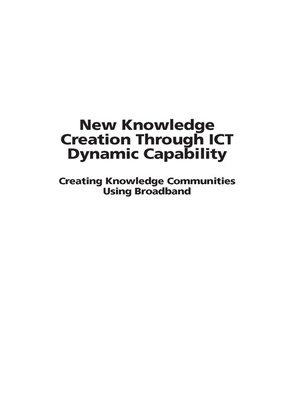New Knowledge Creation Through ICT Dynamic Capability
ebook ∣ Creating Knowledge Communities Using Broadband
By Mitsuru Kodama

Sign up to save your library
With an OverDrive account, you can save your favorite libraries for at-a-glance information about availability. Find out more about OverDrive accounts.
Find this title in Libby, the library reading app by OverDrive.



Search for a digital library with this title
Title found at these libraries:
| Library Name | Distance |
|---|---|
| Loading... |
The progress of broadband ICT is having a big impact on individual lifestyles and corporate activities. For corporate strategy, broadband use goes beyond improving management efficiency to contributing to enhancing customer services and developing new markets. In addition, the shape of corporate organizations and their behavior is changing along with recent changes in the business environment and development of broadband networks. It will become increasingly important for future business strategies to go beyond resources limited by business units within conventional corporate organizations to take positive initiatives with knowledge and competences outside the company as well as with the dynamic use of ICT, through such means as external strategic alliances, virtual corporations, mergers and acquisitions, and outsourcing. This book describes that the full utilization of ICT based on fixed and mobile wireless broadband communication platforms supports managerial speed and excellence, while making it possible to formulate new business models. Chapter 1 describes business process innovations and new e-business that activates the concepts and technology of video-based information networks (VIN) based on the leading broadband and wireless technologies of multimedia communication networks. Dynamic activities with VIN as a future network strategy support tool will enable business innovation through strengthening corporate competitiveness and enhancing customer services. Chapter 2 considers theoretical frameworks related to "ICT dynamic capability" for companies that have employed ICT. "ICT dynamic capability" comprises the three elements of context architecture, boundaries consolidation, and ICT application capabilities, and is discussed from the viewpoint of the new knowledge creation process. The interaction among actors' dynamic use of VIN tools and the community knowledge creating cycle simultaneously enhances knowledge effectiveness and creativity. Chapter 3 goes on to consider the decision-making process that introduced and activated VIN tools within the company, aimed at the acquisition of ICT dynamic capability, from the perspective of a strategy-making process. Chapter 4 demonstrates community management frameworks exploiting VIN in the company through in-depth case study. The top-down approach through the innovative leadership of community leaders who comprehensively manage the business community spread within and outside the company will enable the dynamic use of ICT by community members. In Chapter 5, looking at the creation of business linking industry and academia, the author considers cases of VIN development through a bottom-up approach involving members in the strategic community, and shows analysis from the viewpoint of ICT dynamic capability created from dynamic interaction of context and knowledge with customers who have crossed the organizational boundaries among industries.







